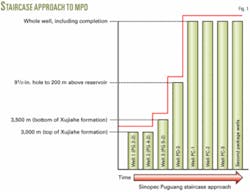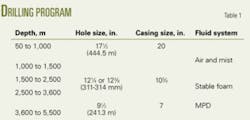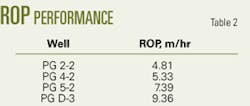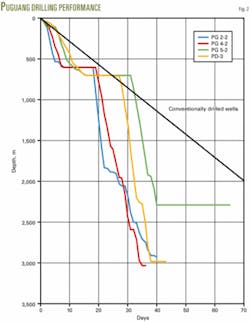Last year, Sinopec improved drilling rates in the Puguang field using percussion (air) drilling and plans to increase its use in the 2007 drilling program.
The first part of this article, published last week, described drilling in the Puguang field, drilling-failure analysis, risk assessment, and the project management road map.
This concluding part discusses the optimized well design, Sinopec’s experiences with percussion drilling using compressed air and foam, MPD system design, and plans for near-balanced operations in the sour-gas reservoir.
Optimized well design
According to the original scope of the feasibility study, the initial recommendation was to apply air and air-hammer drilling to the 17½-in. and 12 3/8-in. sections of the Puguang field, from surface conductor at 50 m to about 3,600 m. Sinopec and Weatherford are currently developing a program to apply MPD in the reservoir section.
This recommendation was made because air drilling in hard-rock formations provides a rate of penetration (ROP) up to five times faster than drilling with conventional fluids. The increased speed not only reduces cost but brings wells online faster. Air drilling produces a straighter hole and, with lower bit weights, results in fewer deviation issues while maintaining good ROP.
A stepwise or staircase approach to applying MPD through all sections of a Puguang well has proven cost effective and satisfactory to the operator (Fig. 1).
The primary objective is to significantly increase the drilling rate to at least double that of previous conventionally drilled wells, from the conductor casing shoe to the setting depth of the 10¾-in. intermediate casing shoe at around 3,600 m (Table 1).
Well design specifications
The wells in the Puguang field are conventional in design:
- 26-in. hole section. This section is drilled conventionally, with a water-based mud system, from the surface to 33 m. The conductor is cemented at a depth of 33-40 m.
- 17½-in. hole section. Air and air hammer were planned for drilling this section from 33-700 m. On both Puguang 2-2 and 5-2, water flows were encountered between 30-40 m. The ground surface-water level must be identified before setting the conductor, and any water flows should be isolated by setting the conductor below this depth. Water flows in the section have significantly affected ROP during percussion drilling.
The section was drilled with air and mist in both Puguang 2-2 and 4-2. In the Puguang 5-2 well, the upper hole section was drilled with air, then with mud when the water flow became too great. On Puguang PD-3, the section was drilled with mud, as Sinopec was concerned about hole collapse after high water production was observed as soon as the conductor was drilled out. This section was cased and cemented with a 13 3/8-in. casing string.
- 12 3/8-in. hole section. This section is drilled with air down to the top of the Xujiahe formation, which contains a number of high-pressure, low-permeability gas zones. A nonrecyclable, stiff foam system is planned for drilling this zone to the top of the Leikuopo formation at 3,600 m. It is cased and cemented with 10¾-in. casing.
The stiff foam system uses an intentionally viscosified liquid phase (base fluid). The increased viscosity of the liquid phase provides a more stable structure by slowing gravity drainage and rupture of the cell walls. Thus, foam with a higher-quality (lower liquid volume fraction) can be created than would be possible without the viscosifiers.
The principal benefit of stiff foam over conventional stable foam is improved wellbore stability in unconsolidated formations through reduced water content of the foam and consequentially avoiding hole collapse.
The stiff foam system is also better able to handle gas production. Should H2S be encountered or gas production be significant (in excess of 1 MMscfd), the well would be killed with mud and returned to the operator for conventional drilling.
Engineers recommended that high-quality foam (more than 90% in the annulus) be used to drill the water-sensitive lower claystone formations in the Puguang field. With a stiff foam system, the foam quality in the annulus can be raised as high as 99.5% before breaking the foam. This level of foam quality would minimize the amount of water in contact with the formations as well and avert water-wetting and associated hole collapse.
- 9½-in. hole section. This section is drilled from the shoe of the 10¾-in. casing to the kickoff point (KOP) at about 4,400 m. Air drilling is planned for this section. There is no further nuisance gas production expected from these depths; therefore, the section is programmed to be drilled with air hammers.
At the KOP at 4,400 m, the well is already 200 m above the sour-gas Feixinguan reservoir. Any underbalanced drilling (UBD) will be halted and the rest of the well will be drilled overbalanced to TD.
At the time of this article, the hole stability of the 9½-in. section had not yet been confirmed and it remains to be determined whether MPD can be used in this section.
Currently conventional mud systems are being used but they provide low ROP. This section currently takes an average of 150-200 days to drill and case to the bottom of the reservoir.
In the reservoir, found between about 4,500-6,000 m, the hole is kicked off with a build rate of 15°/100 m and will be drilled at an angle of 47° to 5,519 m MD. This section is currently drilled by Sinopec using a conventional, overbalanced mud system.
MPD systems
Drilling these wells with managed pressure and air-drilling techniques requires that equipment selection take into account drilling objectives.
- Circulation system. The criteria that drive the design include hole cleaning; managing corrosion; improving shale stability; and maximizing ROP.
With foam playing a large part of the technical solution, the team modeled the flow to determine the best ratios of air, liquids, and chemicals to achieve stable foam at different operating parameters. At these depths, the best parameters were determined to be 2,500 scfm of air, with 10 gpm of liquid.
At these rates there is enough annular velocity to lift cuttings to surface, even with high-quality foam in the annulus. The foam quality is maintained above 90% to minimize the water contact with the formations. The base fluid of the foam is also treated with shale inhibitors to try to improve the shale stability of the system.
- Compressed-air system. This system provides air as the base gas for the compressible drilling fluid. The main components of the system include six air compressors, two pressure boosters, and two mist pumps. The system can provide 7,000 scfm of air and 60 gpm of liquid at 1,500 psi. A nitrogen membrane system is now being considered in the nuisance-gas zones to alleviate the risk of downhole fires.
- Separation. A 48-in. diameter, skid-mounted atmospheric mud/gas separator with a capacity of 24 MMscfd is used in the lower sections of the well.
Mud and solids return to the rig’s mud system from the 10-in. outlet at the bottom of the mud/gas separator to the mud return line. To increase efficiency, a 2-in. line is rigged up from the rig’s mud system to a butterfly valve under the vessel. This configuration will allow for sparging of solids should accumulation occur and for fill-up should the mud seal be evacuated. Also, a mud catch system is used to drain the separator to check for solids.
Gas exits from the top of the separator through 8-in. piping and through an 8-in. flow-check valve installed at ground level. The 200-ft flare line will be routed to the flare pit.
- Choke manifold. The choke manifold rated to 5,000 psi has dual inlet valves for redundancy. The piping and valves are 4 1/16 in. with a 6-in. gut line. The 6-in. gut line allows for a straight-through 6-in. run from the rotating control device (RCD) to a pit or other peripheral. One choke is manual; the other is hydraulic.
- Rotating control device. A 500-psi RCD is placed on top of the well during drilling of all sections above the reservoir. The bottom flange of the RCD is 21¼-in. × 2,000 psi; the outlet flange of the RCD is 11-in. × 3,000 psi.
A high-pressure, passive RCD, with operating pressures of 2,500 psi and dual packer elements, is planned for MPD operations.
- Percussion hammers. The gouging action of roller cone bits is reduced in ultra-hard rock and hammer bits offer a distinct advantage. By imparting high-frequency impacts, coupled with rotation, the natural tendency of the rock to propagate fractures is used to maximize cuttings size while drillstring rotation indexes the bit inserts on fresh rock surfaces during each beat of the air hammer.
Sinopec used 8-in. and 11-in. air hammers in the Puguang wells. Rotations in the 20-30-rpm range and a WOB of less than 2 tons usually provided maximum air-hammer ROP.
- Bits. Air drilling normally uses mining bits. Because the tolerance specifications on mining bits are not as strict as the API oilfield standards, drift diameter of the casing becomes more important. Initially standard mining bits of the following sizes were used to drill the first four wells:
- 444.5 mm (17½ in.).
- 314.0 mm (12 3/8 in.).
- 241.3 mm (9½ in.).
Special impact hammer bits have been designed to drill future wells in hopes of increasing performance and minimizing the number of bits. These bits will be fully diamond-enhanced with protected gauge and face. The diameters of the 314-mm bits are also equipped with enhanced diamond inserts to enhance gauge protection.
Current results, operations
Following a stepped approach to using MPD at Puguang, the objectives for the first two wells were to increase the drilling rate to at least double of previous conventionally drilled wells in sections down to 3,000 m.
Sinopec’s initial four wells took an average of 1 year to drill, with ROPs at 1-2 m/hr. The results of the first two air-drilled wells handily exceeded the objectives. The wells listed in Table 2 also exceeded expectations.
For the footage drilled in the 17½-in. and 12 3/8-in. sections (70-3,000 m), the original conventional wells took 90 days. Current wells using percussion drilling are taking an average of 40 days, which represents a 50% overall reduction (Fig. 2).
PG 2-2
The increase in drilling rate was achieved as the well was drilled from 32 to 2,907 m in 37 days, whereas the initial well drilled in the field, Puguang 2-1, took 78 days to reach the same depth. The secondary objective, to air drill to 3,600 m, was not achieved because of suspected high gas production in the Xijuahe formation. Air drilling stopped at 2,907 m.
Previous conventionally drilled wells had average ROP of 2-3 m/hr. In the first air-drilled well of the field, the average ROP for the 17½-in. section was 9.77 m/hr. The average ROP for the 12¼-in. section, with air, was 12.55 m/hr; with air hammers, the average ROP was only 18.06 m/hr. Overall ROP did decrease in that section, as the BHA was changed to a tricone assembly from 2,492 m for well-control purposes in response to increasing gas production.
Two major incidents contributed to downtime in the operation. The first incident occurred when the rig unintentionally pulled an 8-in. collar into the RCD, which damaged the RCD bearing. The second incident occurred when parted pipe damaged the air hammer. Both equipment items were subsequently classified as unusable junk.
PG 4-2
The next test was to determine whether the initial success on the first well was repeatable. The second well was drilled from 32 to 3,032 m in 33 days, besting the first air-drilled well, Puguang 2-2, which was drilled from 32 to 2,907 m in 37 days. As before, however, Sinopec decided to stop air drilling at 3,032 m because of concerns about gas presence below this depth.
Other highlights from drilling Puguang 4-2:
- Deepest hole drilled with air to date. A total of 2,997 m was drilled from 33-3,032 m.
- Fewer bits used compared to Puguang 2-2. Only three hammer bits were used to drill the 2,997 m.
- Good hole stability. Montmorillonite and mudstone formations were encountered during air drilling. The hole would have easily collapsed and enlarged had mud been used. Air drilling eliminated this possibility.
- Low deviation. At most 1 ton was put on the hammer bit; therefore, the hole was quite straight. According to the survey, hole deviation was only 0.8° at 2,505 m.
The average ROP for the 17½-in. section was 7.71 m/hr. The average ROP for the 12 3/8-in. section was 13.93 m/hr. Average ROP for the whole performance drilling section, from 32 m to 3,032 m, was 12.10 m/hr.
PG 5-2
Unfortunately, this well proved to be less successful primarily because of poor decision-making and miscommunication. Although drilling performance was better than performance of conventional drilling, water influx resulting from high casing setting depths and the inability to drill with foam made this well the worst performer.
Overall, for the section drilled, an increase in drilling rate was achieved. The well was drilled from 40.5 to 2,290 m in 41 rig-days; the actual performance drilling time is 17 days for 40-561 m and 702-2,290 m.
The drilling program was changed, however. Sinopec decided to switch to foam in the air-drilled sections because of safety concerns about drilling with air through a potential gas zone below 2,330 m. Sinopec decided to change from air drilling to foam drilling at 2,290 m without prior warning.
As a result of this unplanned change, there were no experienced fluids personnel on location and the foam was not correctly formulated. As a direct consequence of this foam failure, the hole collapsed completely and the drillstring became stuck. Sinopec commenced the fishing operation and retrieved the BHA 22 days later.
The average air-drilling ROP for the 17½-in. section was 7.52 m/hr. Before the stuck pipe incident, the average ROP for the 12 3/8-in. section, while with air hammers, was 11.98 m/hr. Average ROP for the whole performance drilling section, from 40.5 to 2,290 m, was 10.45 m/hr.
PD-3
Another time record in the Puguang field was set when the 12 3/8-in. hole section of the fourth air-drilled well this year was completed. The section from 700 to 3,000 m was drilled with only two bits and an average ROP of 9.36 m/hr, sustaining the learning curve from the previous wells and resulting in a 94% improvement in ROP over the first air-drilled well in the field.
Sweet gas was encountered at 2,321 m in the Qianfoya formation. The gas was circulated out and flared for about 3 min before air drilling was resumed.
Another sweet-gas zone was encountered at 2,666 m in the Ziliujing formation. The gas flared for about 11 min before air-hammer drilling continued.
Drilling continued, without further gas shows, down to 2,980 m. At this point an attempt was made to drill the deeper, high-pressure nuisance gas in the Xujiahe formation with a foam-based drilling system and the step approach. The foam was mixed with a half life in excess of 15 min and was pumped with a quality of 92 to 99%. Only 10 bbl of water was used to achieve foam circulation to surface and in total, only 35 bbl of water were circulated in the well during the foam operation.
The well was displaced with foam and circulated for 2 hr. A wiper trip was made back to the shoe to ensure hole stability. As the string was run back into the hole, fill was encountered 212 m off bottom. Foam was circulated and the well was reamed, but at that point large amounts of cuttings were being lifted from the well. The kelly was drilled down but there was some rotary table stalling and the well was producing large amounts of cavings. It was obvious that the hole was collapsing and the decision was made to mud up the well.
The foam was blown out of the hole with air and the well was circulated with air for another 30 min. Sinopec decided to pull out of the hole to change the BHA to prepare for mud-up. After 60 m of drillstring was pulled, a tight spot was encountered and air was put back on the hole. After working the string, an additional 40 m was backreamed out of the hole before the string was pulled out.
This exercise, together with the failure on Puguang 5-2, proved that the formations below 2,500 m are extremely water sensitive and that the subsequent hole collapse could probably not have been avoided. Once the well was mudded up, a total of 4 days was needed to redrill the lower 300 m of the well. Sinopec is now more positive in attempting to air-drill the Xujiahe formation, including the nuisance gas formations.
Other highlights from drilling PD-3 are:
- The hammer bit used from 703 to 2,252 m is currently the longest bit run in the field.
- This well was the fastest to reach 2,980 m from start of drilling the intermediate section in the field (10 days).
- Minimal bit use. Only two hammer bits were used to drill the section, including a bit used in the previous well.
- Up until the introduction of foam, hole stability was not an issue.
- Vertical hole was achieved with deviations less than 0.5° recorded. At 2,900 m, deviation was only 0.25°.
Lessons
There were several key operations lessons and a few significant changes from the planned objectives as implemented.
The operator, Sinopec, has successfully employed air drilling on four wells. The individual well times were reduced by 20% and air-drilled sections reduced by 41 days, or 50%.
Using a team-based project approach, the program has maintained an admirable safety record, given the environment. To date, there have been only two minor medical cases and no lost-time incidents.
The application of water-based foam in the zones above the main reservoir (mudstones, siltstones) was not successful. Even with foam quality at 98%, the sensitivity of the formations to water is extreme. The main issue is that the formation below 2,600 m consists of kaolonite, which is 100% soluble, and was identified in the core sample studies.
The only other possible option to using pure air or N2 would be to drill these formations with an oil or diesel-based foam system.
Nonproductive drilling time in the Pugaung field is significant. Unusual drilling practices and philosophies caused numerous delays. Adopting API standards and establishing a best practices culture are essential to achieving better drilling performance in China. As much as both parties would like to adopt a technical limit methodology, there are more significant issues to be addressed, which are primarily culture and role related.
As the team addresses these issues, however, several opportunities for further reducing the drilling curve have been identified:
- Batch drilling sections down to the reservoir.
- Drilling 26-in. conductor below the aquifer to 70 m.
- Inspecting drillstring to maintain API standards.
- Adopting cementing best practices.
There are many other areas that, if addressed, could result in additional savings. The team believes drilling and completing these wells in fewer than 120 days, as opposed to 200, is achievable.
Future of MPD
The sour-gas Feixinguan reservoir is located between 4,700 and 6,000 m below surface. The geology encountered consists primarily of mudstone, siltstone, and shale sequences above the productive reef. This oolitic dolomite reservoir has a porosity of about 3.65 to 8.71% and permeability that varies from 0.1 to 126 md. The average initial formation pressure approximates 7,977 to 8,267 psi (55 to 57 MPa), with a formation pressure gradient of about 1.09 to 1.18 sg. The reservoir formation temperature is estimated at 120º to 133º C., with an initial gas saturation of 90%. The reservoir has gas productivity from its original vertical wells between 10 and 20 MMscfd.
This reservoir is deep, high pressured, and extremely sour. From a risk-analysis perspective, these wells would have the highest risk classification in the world if UBD were applied. Using in-house risk assessments and reservoir screening tools, the Feixinguan reservoir scored poorly as a UBD candidate.
The mean score of +18 from the reservoir screening tool indicates that the reservoir is an average candidate for underbalanced reservoir drilling (in terms of average horizontal candidacy and APTi), but the low susceptibility to damage and low clay content of the reservoir, in combination with the sour and high -pressure characteristics, made it a poor UBD candidate.
In addition, the operations risk-assessment score of 8.3 is extremely high and there is no record in the world of a well with such high levels of H2S at this depth ever having been drilled underbalanced. There are also political factors to consider, as China has currently banned UBD operations in sour-gas reservoirs.
Consequently, MPD methods will be applied at close-to-balanced conditions to achieve the main objective of improving ROP in the reservoir. At the same time, increasing the angle through the reservoir to about 80° should also provide further reservoir exposure and potentially increase productivity.
Drilling ROP drops significantly to less then 1 m/hr with borehole pressures reaching 10,000 psi. Drilling the reservoir section currently takes 70 to 90 days. At this moment in the project, MPD packages are not designed to drill large productive horizons. Air-drilling operations are suspended if any potential gas or oil zones outside of the design parameters are penetrated.
The proposal is to drill the reservoir with minimal overbalance or at balance, with a fluid designed to minimize reservoir damage. Optimizing drilling performance through the use of motors, advanced rock-bit technology, improved drilling hydraulics and solids control systems in combination with MPD well-control equipment, should allow significantly improved drilling rates and, at the same time, reduce reservoir damage.
The surface equipment deployed for MPD operations will ensure that any H2S produced to surface can be safely handled with the gas busters and flare systems. Further improvements in rig hydraulics and solids control equipment will also help to reduce drilling times.
Optimizing well cleanup, combined with optimizing the running of the completion tubulars, will allow further overall time savings.
Recommendations
Since the initial Puguang wells were drilled and completed in years per well, conventional drilling was deemed uneconomical. Thus, Sinopec decided to test air drilling and MPD techniques in an initial two-well trial.
After the trial was successful, extensive air drilling was used in subsequent wells, and more than 15 rigs are scheduled for drilling this year. The additional use of MPD in the non-reservoir sections would result in:
- Increased ROPs and shortened drilling curves.
- Reduced bit use.
- Enhanced overall drilling performance through reduction of vibration, drillstring-related problems, and sticking potential.
The most attractive reason to use MPD systems in the field is to achieve and support the goal of drilling three wells/rig/year. The field has a tight delivery schedule, and initial performance (long drilling times) was creating doubt that production targets would be reached.
The initial use of percussion drilling in the Puguang field produced excellent results, so far demonstrating that:
- Air drilling is highly successful in the surface formations.
- Formations down to 3,000 m are extremely water sensitive.
- The project management road map works effectively in addressing engineering and operational design.
- The project team approach works and can be implemented in China with cooperation of the operator.
Acknowledgment
The authors thank Sinopec and Weatherford for permission to publish this article.






